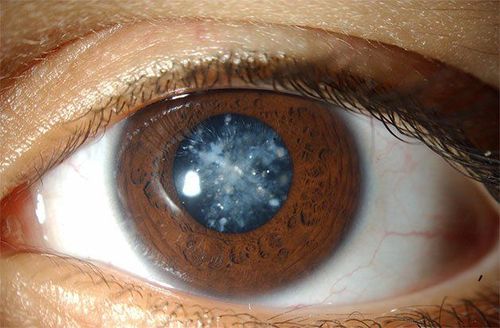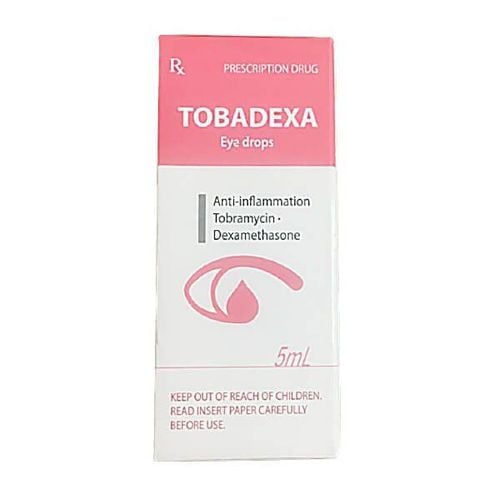This is an automatically translated article.
Nepaflam is the preferred drug class indicated for the treatment of eye-related diseases such as reducing eye pain, irritation and redness after cataract surgery. So what exactly is Nepaflam? What is Nepaflam used for? The following article will help you better understand the uses of Nepaflam.
1. What does Nepaflam do?
Nepaflam belongs to the group of non-steroidal anti-inflammatory drugs (NSAIDs). The drug has the main ingredient Nepafenac 5 mg. After taking a single dose of eye drops, Nepafenac penetrates the cornea and is converted into enzymes necessary for the formation of essential fatty acids for the body.Nepaflam is indicated for the treatment of pain after cataract surgery and inflammation associated with cataract surgery.
On the other hand, patients who are allergic to the main active ingredient Nepafenac or any of the excipients are also not prescribed.
2. Usage of Nepaflam blood pressure medicine
Patients need to use Nepafenac eye drops exactly as directed. Do not use more or less than prescribed by your doctor. Wash your hands thoroughly before and after instillation, avoid touching the tip of the dropper to your eyes, close the cap tightly after use, keep the vial in a dry, clean place.
The recommended dose of Nepaflam is one drop in the perioperative conjunctival sac 3 times the day before surgery. Continue as if on the day of surgery and throughout the first 2 weeks in the postoperative period.
In case of forgetting a dose, the patient should drop the medicine as soon as he remembers. However, if it is almost time for your next dose, skip that dose and continue your dosing schedule as directed. Do not double dose to make up for the missed dose.
3. Precautions when using Nepaflam
To make sure it is safe to use Nepafenac for your eyes, tell your doctor if you have: Diabetes; Dry eye syndrome; Arthritis; Bleeding or blood clotting disorders, such as hemophilia... Before using Nepafenac eye drops tell your doctor and pharmacist if you are allergic to Nepafenac; Aspirin or other NSAIDs such as diclofenac (Voltaren), ibuprofen (Advil, Motrin), naproxen (Aleve, Naprosyn), or tolmetin (commercial Tolmetin); any other medicines, or any ingredients in Nepafenac. Avoid exposure to sunlight while taking Nepaflam. Use of topical NSAIDs can cause keratitis. In some susceptible patients, continued use of topical NSAIDs may result in epithelial damage, corneal erosion, ulceration, or perforation of the cornea, events that may threaten vision. . Patients with damage to the corneal epithelium require immediate discontinuation of the drug and close monitoring of the corneal condition. Nepaflam should be used with caution in patients with known hemophilia tendencies or in patients receiving treatment with medicinal products that prolong bleeding time. There are no data on the concomitant use of prostaglandin analogs with Nepafenac. Based on their mechanism of action, concomitant use of these drugs is not recommended. Nepaflam contains benzalkonium chloride which can be irritating and known to discolor soft contact lenses. Additionally, patients are NOT recommended to wear contact lenses after cataract surgery. It also means that patients should not use contact lenses during treatment with Nepaflam. Excipients Benzalkonium chloride is a preservative commonly used in eye drops that has been reported to cause toxic corneal ulceration and subepithelial keratopathy. Patients should be closely monitored when regular or prolonged use of Nepaflam eye drops is required. Acute bacterial eye infections may be masked by the use of anti-inflammatory drugs. NSAIDs have no antibacterial activity. In the case of a patient with an eye infection, caution should be exercised when NSAIDs are used with antibacterial agents. Nepafenac is likely to be cross-sensitized to phenylacetic derivatives, acetylsalicylic acid and other NSAIDs. As with other eye drops, transient blurred vision or visual disturbances may affect the ability to drive and use machines. If blurred vision occurs during instillation, wait until your eyes are clear before driving or operating machinery.
5. Nepaflam side effects
Nepafenac can cause side effects such as: headache, runny nose, pain when seeing, nausea, vomiting, dry eyes, itchy eyes.
Some side effects can be more serious, call your doctor right away if you experience the following symptoms: red or bloody eyes, eye pain, feeling something is in the eye, sensitivity to light, blurred vision, see spots, watery eyes.
Please dial HOTLINE for more information or register for an appointment HERE. Download MyVinmec app to make appointments faster and to manage your bookings easily.













